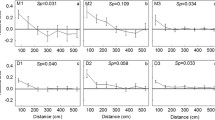Abstract
This note reports on an extraordinary polygamous population of Salix acmophylla from Nahal Dishon, Israel. Remarkably, all individuals in this population are bisexuals, that is, they all contain typically female catkins (with some or without any male florets), typically male catkins (with some or without any female florets) and mixed catkins. The proportions of these three catkin types in populations are 36.3%, 46.8% and 16.9% respectively. The fertility of these willows was found to be poor: no mature seeds were found at all and mean pollen stainability was low as 15.6%. The possible reasons for this semi-sterility are discussed.
Similar content being viewed by others
References
Atlan A, Gouyon PH, Fornial T, Pomente D and Couvet D (1992). Sex allocation in an hermaphroditic plant: the case of gynodioecy in Thymus vulgaris L. J Evol Biol 5: 189–203
Browicz K and Zielinski J (1990). Chorology of trees and shrubs in South-West Asia and adjacent regions. vol 7. Polish Scientific, Warsaw-Poznan
Burkill JH (1898). Changes in the sex of willows. Ann Bot 12: 557–558
Charlesworth D and Charlesworth B (1981). Allocation of resources to male and female functions in hermaphrodites. Biol J Linn Soc 15: 57–74
Charnov EL, Maynard Smith J and Bull JJ (1976). Why be an hermaphrodite. Nature 263: 125–126
Darwin C (1877). The different forms of flowers on plants of the same species. John Murray, London
Falinski JB (1998). Androgyny of individuals and polygamy in populations of Salix myrsinifolia Salisb. in the south-western part of its geographical range (NE-Poland). Persp Pl Ecol Evol Syst 1/2: 238–266
Heslop Harrison JW (1924). Sex in the Salicaceae and its modification by Eriphoyid mites and other influences. Br J Exp Biol 1: 445–472
Rohwer JK and Kubitzki K (1984). Salix martiana, a regulary hermaphrodite willow. Pl Syst Evol 144: 99–101
Rottenberg A (2000). Fertility of exceptional bisexual individuals in four dioecious species. Sex Pl Reprod 12: 219–221
Rottenberg A, Zohary D and Nevo E (1999). Patterns of isozyme diversity and vegetative reproduction of willows in Israel. Int J Pl Sci 160: 561–566
Smith EC (1940). Sex expression in willows. Bot Gaz 101: 851–861
Wolfe LM and Shmida A (1997). The ecology of sex expresion in a gynodioecious Israeli desert shrub (Ochradenus baccatus). Ecology 78: 101–110
Author information
Authors and Affiliations
Corresponding author
Rights and permissions
About this article
Cite this article
Rottenberg, A. Fertility and sexual structure in a polygamous willow population. Plant Syst. Evol. 268, 257–260 (2007). https://doi.org/10.1007/s00606-007-0573-7
Received:
Accepted:
Published:
Issue Date:
DOI: https://doi.org/10.1007/s00606-007-0573-7




